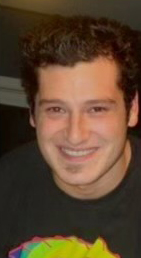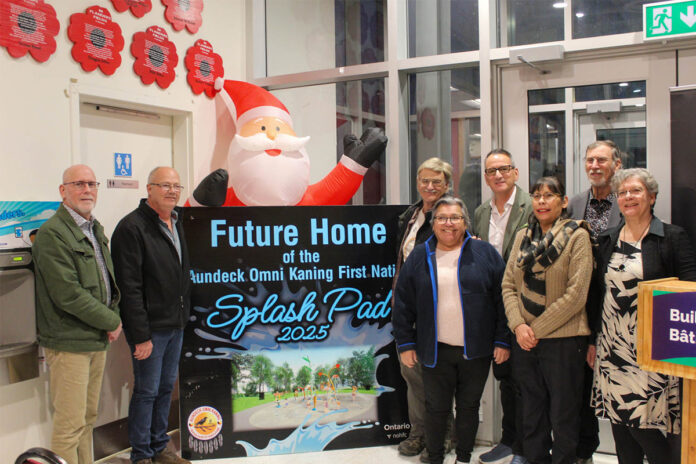Land-based model of healing
AUNDECK OMNI KANING—Gwekwaadziwin Miikan Youth Mental Health and Addiction Program provides an innovative land-based and long-term approach to tackling the current challenges, challenges that have surpassed “crisis” levels all across Turtle Island and beyond.
This past week, the program based in Aundeck Omni Kaning First Nation hosted an open house that not only included tours of the site, but also offered free harm-reduction and Naloxone kits.
Gwekwaadziwin Miikan Youth Mental Health and Addiction Program is “a three-phase program that offers land-based treatment, live in after care and community aftercare programs for young adults 19-plus struggling with addictions and other mental health issues. While the live in aftercare program and head office are located in Aundeck Omni Kaning. Although Gwekwaadziwin Miikan’s programming weaves traditional culture with therapeutic best practices and outdoor experiential learning to offer a full spectrum of care for individuals on their path to recovery, its programming is available to everyone.

Harm Reduction Team lead Stephanie Corbiere took The Expositor on a tour of the facilities.
“We have enough beds to house 10 folks for withdrawal management,” she said, “but when we start our program we’re going to start with a five-bed capacity.” The program is still in the process of filling out its roster of workers, she noted.
The clients in the program will be staying in small bunkies on the property. “They are simple but quite nice and they have heating and cooling in them,” explained Ms. Corbiere. “That they can adjust as need be.”
Nestled amongst the bunkies is a central arbour within which burns a fire. The arbour works as a teaching space and place of ceremony. “We recently had this built this summer,” said Ms. Corbiere. “This area will be used a lot for our programming, such as group circles morning and night, sharing circles, traditional teachings and different things around the culture.”
Off to one side is a long, raised building within which are showers and bathrooms for the clients. “We have four showers in total,” she said. “Each of them have enough space to fold clothes and there is a laundry room, so we can do our laundry.”
Other bunkies serve as meeting rooms, storage lockers for personal effects surrendered until the end of the program. “This provides a safe space for their personal items,” said Ms. Corbiere. “Some of the people coming in will homeless off the street and be carrying everything they own with them, given the life they may be leading when they come to us.”
Two of the resident bunkies contain two single beds, while two have just a double bed. One of the bunkies even has a bunk bed to bring it up to three.
One of the admin office bunkies comes with a side room that has a glass wall. The transparent wall is there to allow for monitoring of patients going through withdrawal, explains Ms. Corbiere. Being able to ensure safe monitoring will ensure both client and staff are kept safe and sound throughout the process.
Another bunkie contains bins on racks. “When folks come in and are needing to be clothed, there are sweaters, jogging pants, T-shirts and this whole bottom row is filled with Crocs,” she said. That makes it possible for clients to access the showers and making sure they have proper footwear on.
“It’ll be our shoes that we’ll use on site as well in the world,” said Ms. Corbiere. Plans are in place for winter boots, coats and other gear necessary to safely engage in the land-based healing program.
“This cabin is going to be my office used for admission,” said Ms. Corbiere, indicating a bunkie with desk, chairs and computer. “So we can have those conversations of meeting people where they’re at and then also having discussions around discharge and what that looks like for folks.”
In another cabin tables are laden with Naloxone kits (used to counteract overdoses) and safe injection kits. “A lot of our harm reduction supplies will be stored here,” she said. “We have the straight stems (pipes); we have bowl pipes as well. These are like inhalation kits for folks, we also have one use foil so they can make inhalation tubes.”
There are also condoms, both male and female condoms, as well as dental dams. “We have lubricant and non-latex condoms as well, and ,of course, we’re handing out a Naloxone kit,” said Ms. Corbiere. Smaller packs contain just refills for the kits.
Ms. Corbiere noticed that The Expositor has a Naloxone kit in their camera bag. “So, folks, like yourself, if you just need the refill, you can just get this because you already have the fancy black case for it.”
“Anybody that’s using injection needles, these are provided with all their cooking equipment to make sure that they’re doing it safely to prevent the spread of illness,” she explains. “Once they’re ready to leave our program, and maybe that’s where they’re at, they’re like ‘I’m not ready to stop using yet’ they can definitely leave with the material to help keep them safe.
Even if someone is not part of the Gwekwaadziwin Miikan program they can stop in and get a kit, she confirms. “There is a little intercom station down below near the entrance off the highway (540) said Ms. Corbiere. By calling on the intercom and explaining what is needed, someone from the program will come down.”
“I can actually FaceTime the person on a phone,” she said. “So, if they buzz in and they say ‘Hey you know, it’s me, John, and I’m here just to pick up a harm reduction kit, can you bring down?’ We can bag it up and meet them down below, so you don’t necessarily have to be an in-housed participant.
There is also accommodation available for longer periods of time. “They can stay in there for up to a year,” said Ms. Corbiere. “That’s for folks that may be going back home or to their community where the situation hasn’t changed. And we’re just kind of throwing them back to the same environment.”
“So they can live in that house for up to a year and for folks that maybe are struggling with a housing crisis because that’s all across the country, they can apply to live in our five-plex unit. We have five beds in that brown building down below and folks that still might not have a safe place to go. Maybe they require some more independent living skills before returning home.”
“That requires having shown enough responsibility and maturity because that place over there is not staffed, 24/7,” said Ms. Corbiere.
“We do have a worker, his name’s Charlie, he’s the aftercare worker and he kind of goes in and checks on folks that are there,” she said. “As well as everybody else that’s out in community. That’s his domain. But people can stay for an additional year in that house so we can potentially have people here for almost three years if they start with detox and withdrawal management, and then we transition or they’re committed to treatment at our 90-day land-based program. We can go from here to there to there to there and then they also get community aftercare for an additional six months.”
Although the program is open to everyone, they are aimed at servicing local residents, like Manitoulin, as much as possible. “That’s our priority,” she said.
“And as long as they’re open Anishnaabe culture, so as long as they’re willing and open to be part of morning circle, we do evening circle, there’s traditional teachings—a lot of our group work is based around Red Path, which is a culturally-based treatment model that we use out on the land.”
“Our 90-day land-based program is open to everybody in Ontario, as long as they have a valid Ontario Health Card and are 19 and older,” she said. “Theres no fee.”
“We don’t have a funding budget for travel right now,” said Ms. Corbiere. “That’s in the works and for the future, we have to kind of start our pilot project and then explain why we need it. So, we’re really hoping that the frontline workers or support people those folks, whether it be parents, caregivers sisters, brothers, aunts or uncles, that is an important part of that connection—helping them to access our services because we don’t have it to transport. We are a non-medical detox. So, what that means is we don’t have nurses and doctors on site for the entire stay. So, we have a partnership with the local hospitals and in Mindemoya, as well as Little Current for those that are experiencing acute withdrawal. So, if anybody’s needing to be medically observed and supervised—we do a transfer to emergency. Once they’re stabilized and are healthy enough to finish out their withdrawal with us they can be transferred to us, then that frees up their hospital bed, so it’s like a continuum of care and it makes huge sense.”
The program does have a nurse from the Northeastern Manitoulin Family Health Team who comes by once a week if clients require some medical care. “Some of our people haven’t seen a medical profession or their family doctor in a very long time,” she said. “Or don’t go regularly. So, in terms of that, if anybody comes in like say they might have an abscess or a wound, that doesn’t necessarily mean, you got to go to the hospital, but you’d still like to get it checked, we would probably do what we would call a timed admission, so we want to make sure that they’re here with us on a Thursday or Friday so that they can get that appointment and be seen to make sure that they’re, they’re okay.”
When the program is in full operation they will be open on Thursdays from 4 pm till Mondays at 8 am. “Oftentimes services are Monday to Friday, and they close or they’re running 8:30 am to 4:30 pm,” said Ms. Corbiere. “So, we wanted to bridge that gap of service and allow people to have somewhere to go especially on weekends. So that’s kind of where, where that went and eventually, we do want to be 365 days a year.”
Thursday will be more of an intake, while Monday will be more of a discharge day. “But we could take people in if we have a bed available anytime throughout that process as well,” she said.
“Once we get operational and fully running, we’ll have a contact number to reach for a pre-screen and then our application,” said Ms. Corbiere. “The other thing is our application is going to be the same as our 90-day land-based application, because that’s a part of decreasing barriers. So, I didn’t want to create an application for withdrawal and then if they say, well now, I want to go to the land-based program—now you have to fill it in another application. Instead, we will have just one. We’ll get the information that we most need—let’s care for you first, right? That’s kind of our philosophy here. Sometimes paperwork comes second—human lives come first.”
As to the opening date, “We’re still in the hiring process,” said Ms. Corbiere, “but for harm reduction supplies we are up and running so they can call the office.”
Gwekwaadziwin Miikan Youth Mental Health and Addiction Program’s main line is 705-377-5307. That will connect with Ms. Corbiere’s extension. “They can call me and leave a call back number and we’ll arrange a time for pickup. And even a drop off of sharp needles, as well. If that’s what they prefer to do, instead of taking it to pharmacy themselves.”





